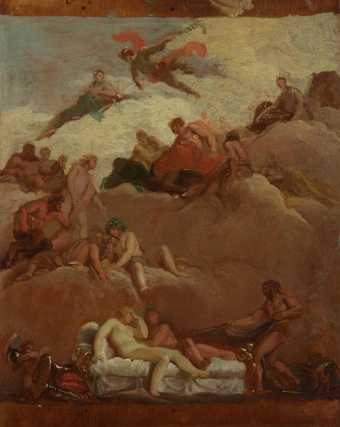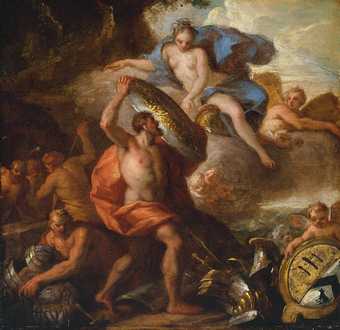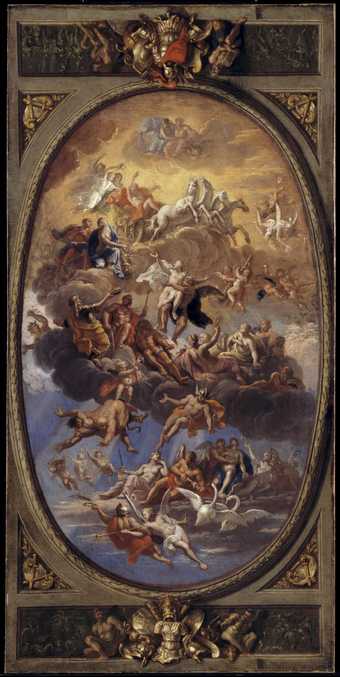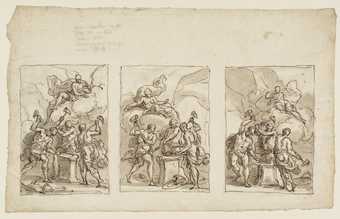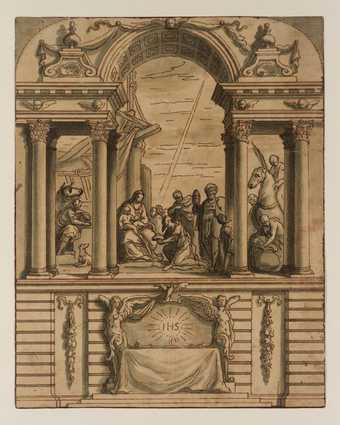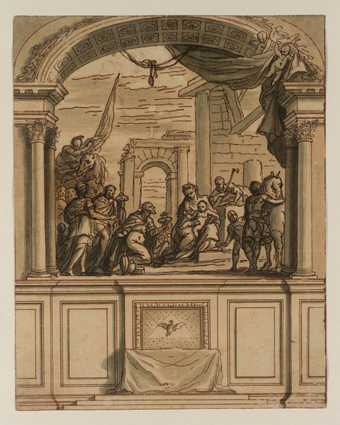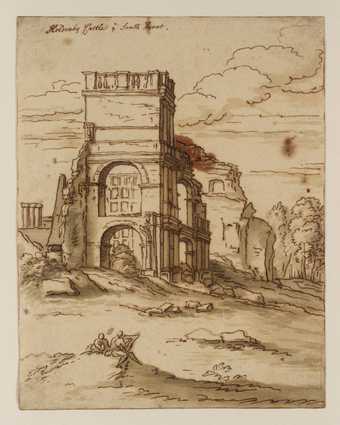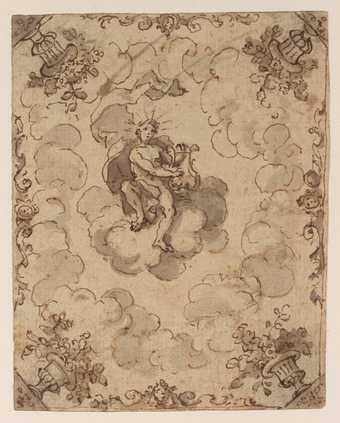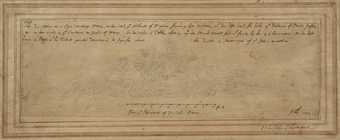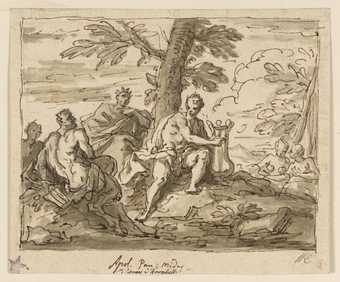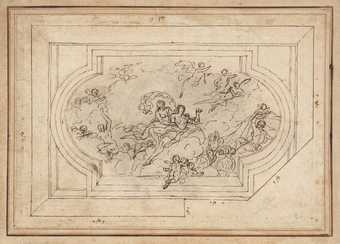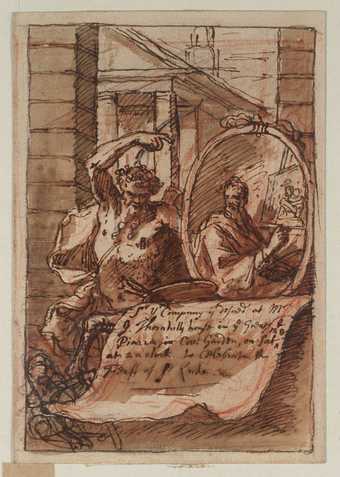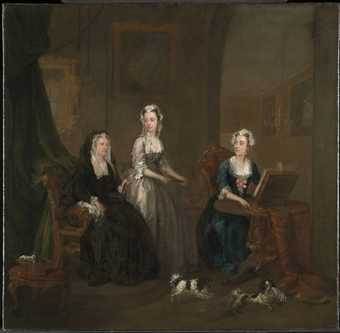
In Tate Britain
- Artist
- Sir James Thornhill 1675 or 76–1734
- Medium
- Oil paint on canvas
- Dimensions
- Support: 457 × 521 mm
frame: 584 × 643 × 75 mm - Collection
- Tate
- Acquisition
- Purchased 1953
- Reference
- N06200
Display caption
This is probably part of a decorative scheme for Hewell Grange, the seat of the Earl of Plymouth, which was destroyed in the nineteenth century. The story of Romulus and Remus, the founders of Rome, was a favourite subject for the mansions of landowners who prided themselves on their classical learning and who saw parallels between eighteenth-century Britain and the rise of the Roman Empire. As the only British-born decorative painter of note, Thornhill catered wholeheartedly for this taste and played on native pride to thwart foreign competition. Some of his aggressive chauvinism was later taken over by his son-in-law William Hogarth.
Gallery label, August 2004
Does this text contain inaccurate information or language that you feel we should improve or change? We would like to hear from you.
Catalogue entry
N06200 The Apotheosis of Romulus: Sketch for a Ceiling Decoration, Possibly for Hewell Grange, Worcestershire c. 1710
Oil on canvas 460×520 (18 1/8×20 1/2)
Purchased (Cleve Fund) 1953
PROVENANCE ...; bt H.D. Molesworth in Brighton 1939 (as by Tintoretto) and sold to H. Calmann 1953
EXHIBITED Pittura inglese 1660–1840, BC, Palazzo Reale, Milan 1975 (20, repr.)
LITERATURE Croft-Murray 1962, p.270
This sketch for an oblong ceiling design in a painted false stucco surround with indented corners, represents the reception of a hero in Olympus. He is shown stepping out of a horse-drawn chariot and being presented to the assembled gods by a helmeted Mars.
A ceiling composition similar in overall shape and concept but less precise in detail can be found in Thornhill's sketchbook in the British Museum (fig.60, 1884-7-26-40, p.65 recto), inscribed ‘Ld. Plimouth's Hall. Ceil. 18 ftt high at Hewill Hall near Bromsgrove’. This refers to Hewell Grange, the Earl of Plymouth's seat in Worcestershire, which was destroyed at the end of the last century and of which little record remains.
Iconographically, the hero represented here appears to be Romulus, who, according to Ovid (Metamorphoses, Book XIV), was taken up to Olympus in the chariot of his father Mars. The canine silhouette behind him would then be the She-wolf of Rome, an animal sacred to Mars, who nurtured the hero in infancy. Its turned head is almost identical (in reverse) to that in a roundel drawing of the She-wolf nursing Romulus and Remus in Thornhill's sketchbook (BM accession no. 1884-7-76-40, p.33, recto), where it is part of a sequence of sketches dealing with the Romulus legend, thought to be unused designs for Stoke Edith. The She-wolf also accompanies Romulus in the apotheosis of the hero on the ceiling of the Second George Room at Burghley House painted sometime before 1691 by Antonio Verrio. Although the designs in no way resemble each other, Verrio was a profound influence on the much younger Thornhill, who studied his work closely and may have even worked with him in about 1702–4.
Various elements in the design are echoed in a number of sketches of heroic apotheoses in the British Museum sketchbook, and a possibly related oil sketch was lent by Sir Lawrence Gowing to the Thornhill exhibition at the Guildhall Art Gallery in 1958(1).
Published in:
Elizabeth Einberg and Judy Egerton, The Age of Hogarth: British Painters Born 1675-1709, Tate Gallery Collections, II, London 1988
Explore
- architecture(30,960)
- universal concepts(6,387)
-
- power(210)
- classical(198)
- actions: postures and motions(9,111)
-
- flying(173)
- crowd(646)
- apotheosis(4)
- transport: land(2,189)
-
- chariot(21)
You might like
-
Louis Chéron Vulcan Catching Mars and Venus in his Net
c.1695 -
Sir James Thornhill Thetis Accepting the Shield of Achilles from Vulcan
c.1710 -
Antonio Verrio Sketch for a Ceiling Decoration: An Assembly of the Gods
c.1680–1700 -
Sir James Thornhill Three Studies for ‘Thetis in the Forge of Vulcan Watching the Making of Achilles’ Armour’
c.1710 -
Sir James Thornhill A Ceiling and Wall Decoration
c.1715–25 -
Sir James Thornhill Architectural Decoration, Design for an Altarpiece: Scene under a Barrel Vault Supported by Four Pairs of Detached Columns
date not known -
Sir James Thornhill Architectural Decoration, Design for an Altarpiece: Scene under a Wide Vault Supported by Two Pairs of Columns
date not known -
Sir James Thornhill Holdenby Castle ye South Front
date not known -
Sir James Thornhill Apollo: Design for a Ceiling
date not known -
Sir James Thornhill Design for the Pediment of Queen’s College, Oxford
1716 -
Sir James Thornhill Apollo, Pan, Midas. A Decoration
date not known -
Sir James Thornhill Design for a Ceiling with Curved Ends. Verso: Numerous Designs for the Central Motif
date not known -
Sir James Thornhill Invitation Card for the Feast of St Luke, with a Sketch of the Pediment of a Greek Temple
1718

